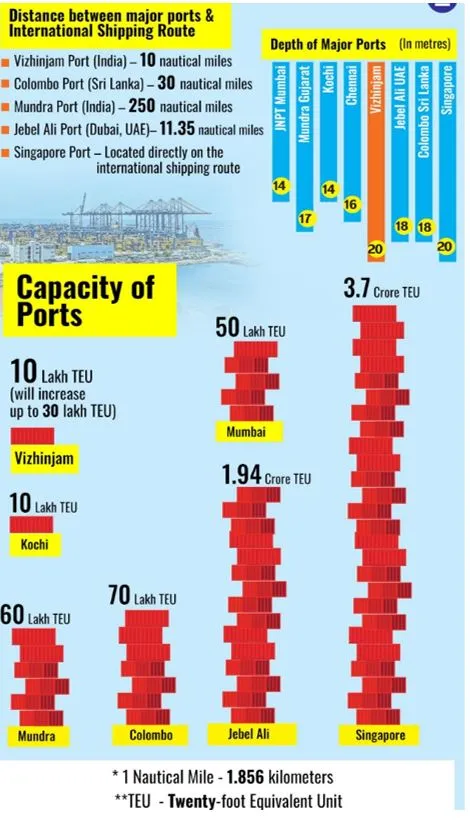

2nd May 2025 (10 Topics)
Context
Prime Minister Narendra Modi inaugurated the Vizhinjam International Seaport in Kerala. This marks the commissioning of India’s first deepwater transshipment port, aimed at transforming India into a global shipping and logistics hub, reducing dependence on foreign ports, and enhancing maritime self-reliance.
What is the Vizhinjam Port Project?
- Vizhinjam is a container transshipment terminal. It is India's latest international deep-water transshipment facility.
- It is situated in the southern part of Kerala, India, near the state capital, Thiruvananthapuram.
- Type: Deepwater container transshipment port
- Model: Public-Private Partnership (PPP)
- Operatorship:
- Adani Ports & SEZ Ltd (28.9%)
- Kerala Government (61.5%)
- Union Government (9.6%)
- Current Capacity: 1 million TEUs (to expand to 7.4 million in future phases)
- First vessel handled: MSC Türkiye — one of the world’s largest container ships (24,000+ TEUs)
- Transshipment Port: A transshipment port is where containers are transferred from large "mother vessels" to smaller feeder ships for onward delivery to regional destinations.
- These ports are crucial for global shipping efficiency, especially for countries with significant import/export volumes but no large-vessel handling capacity.
- Until now, 75% of India’s transshipment cargo was handled through foreign ports like (It made movement of goods slower and more expensive):
- Colombo (Sri Lanka)
- Singapore
- Jebel Ali (UAE)
Why Vizhinjam is a Game Changer?
- Strategic Location: It is just 10 nautical miles from the busy East-West global shipping route. Vizhinjam’s location connects key global ports like Shanghai, Busan, and Rotterdam with major Indian ports, giving Kerala an edge in global logistics.
- Natural Deep Draft: It is deep enough (20 meters) to accommodate Ultra Large Container Vessels (ULCVs) — without artificial dredging. It saves huge costs and avoids environmental damage
- Low Maintenance: Minimal littoral drift (sand movement) makes it cheaper to maintain than most Indian ports
- Reducing Logistics Costs: India currently loses USD 200–220 million annually by outsourcing transhipment. Domestic exporters pay USD 80–100 extra per container due to foreign port usage

Fact Box: Ports in India
|
More Articles

